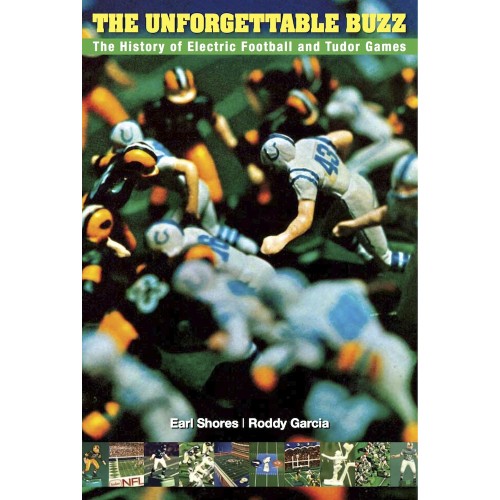History and Background

History and Background
Electric Football's ancestry can be traced all the way back to 1929, when Elmer Sas incorporated Tudor Metal Products in New York City. The company survived the Depression and in the late 40's, Elmer's son, Norman became president of Tudor. Norman Sas invented the game we all know and love, Electric Football.
Norman based the football game on a vibrating car race game that Tudor already made. Those early #500 Electric Football models look crude to the modern eye, but imagine being a child on Christmas morning in 1949. No spinners, no dice, no cards to flip over. Just turn on the game and watch your players run all by themselves!
Electric Football was an immediate hit, captivating imaginations like few toys ever had. Tudor did so well with the game that four companies also entered the fray. Over the decades, some of Electric Football's greatest innovations would come out of the competition between the companies
Tudor produced the first all-plastic 3D players in the 60's thanks to an industrial designer named Lee Payne, who showed Norman a new set of player prototypes whose additional realism would change Electric Football forever. Tudor introduced these players on its first large game, the #600 model.
Now having the only figures in five different realistic 3D football poses, Lee sold Norman on the idea of painting the figures using actual NFL uniform colors. Lee was instrumental in working with the creative services department of the NFL to obtain the NFL license for making quality NFL-looking teams that every kid then, and today, just has to have!
By now Payne was working directly for Norman at Tudor as head of product development. He began taking the game boards to new heights with more realistic fields and lithographed crowd scene backgrounds complete with scoreboards. Payne used a softer plastic material to develop the Triple Threat Quarterback (TTQB) that can run, pass, and kick.
In 1967 Tudor introduced its new flagship Model 620, complete with an improved metal playing surface, cardboard backdrop scoreboard, NFL-style goal posts and NFL painted teams. This quickly set the standard for Electric Football, making the game even more popular, allowing Tudor Games to be the number one choice when selecting an Electric football game. Later, to make these realistic figures more enjoyable Tudor Games went on to create the "TTC" or Total Team Control base with its directional dial allowing finer route control and all new strategies.
Tudor's creative genius is still appreciated today by Electric Football hobbyists and collectors alike. In 1990 Tudor Games was sold to Miggle Toys and the game was nurtured, preserved, and made popular again creating another generation of game hobbyists and enthusiasts.
New ownership acquired the company in February of 2012. With the help of local, national, and even international Electric Football Nation enthusiasts, an energized Tudor Games company is making products for new generations of sports fans, game players, hobbyists, and collectors. Tudor Games is committed to building new and innovative products for today's consumer. Our hands-on games have delighted folks for generations. We appreciate your support and encourage you to start your own tradition of Electric Football with friends, family, children and grandchildren!
From all of us at Tudor Games - thanks for visiting our site and supporting Electric Football!

NFL Documentaries
For many of us, Electric Football may evoke memories of childhood, with the sound of miniature players buzzing around a vibrating board, set up in a friend's basement or living room. But did you know that Electric Football has been around for over 70 years and is still going strong today? In fact, it has even evolved into a competitive hobby with a dedicated following. If you're curious about the fascinating history and resurgence of Electric Football, you need to watch the documentary film "Electric Football in the Modern Age" by Porter Street Pictures. This film offers a unique insight into the game, the people behind it, and the community of enthusiasts that has kept it alive and thriving.
Watch the full video on Youtube below:
Collector Information
Learn about the different types of Electric Football action figures, including their sizes, platforms, and sculpting details. From classic "67 Big Men" to modern Standard figures, this guide explores the evolution of the hobby and highlights key player poses and collectible sets. Discover which figures are best for your game and collection.
History of Electric Football: Slideshow
Slide show images courtesy of the authors of The Unforgettable Buzz. More Electric Football history is available at theunforgettablebuzz.com.
Two recently published books also cover the history of Electric Football in great detail:
The Unforgettable Buzz: The History of Electric Football and Tudor Games is the first book ever published on the topic of Electric Football. Written by Earl Shores and Roddy Garcia, and designed by Michael Kronenberg, the book has garnered great acclaim since its release in 2013. The book is an unparalleled 652-page chronicle of the Electric Football story, having been featured in the ESPN documentary "The Subterranean Stadium."
Full Color Electric Football™ is an epic 124-page all-photo journey through the history of America’s most iconic sports toy. This book brings treasured childhood memories to life using over 250 color images to create a seamless visual display that transcends the individual elements. Not only does Electric Football become the stuff of our dreams, in Full Color Electric Football™ the game becomes art.
Electric Football Books
Full Color Electric Football Book
Displayed on page after glorious color page is the full legacy and history of Electric Football. NFL..
$24.95
The Unforgettable Buzz Book
The Unforgettable Buzz was inspired by a simple premise: For millions of Baby Boomer boys, finding a..
$24.95



